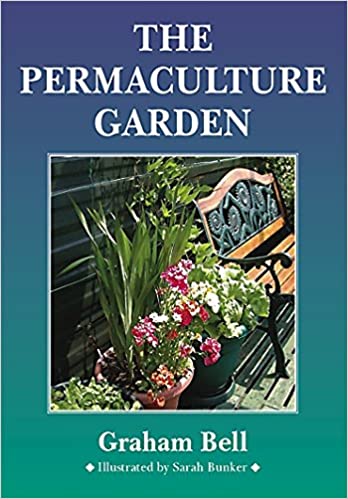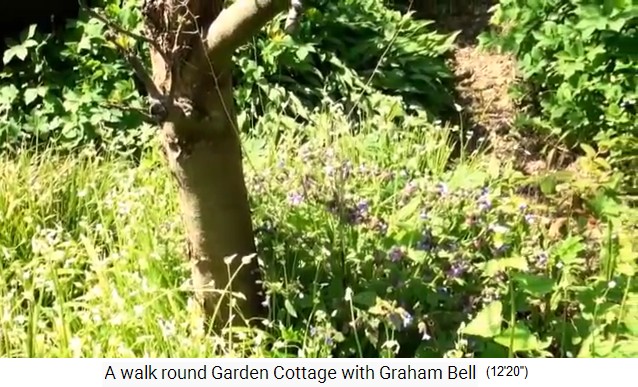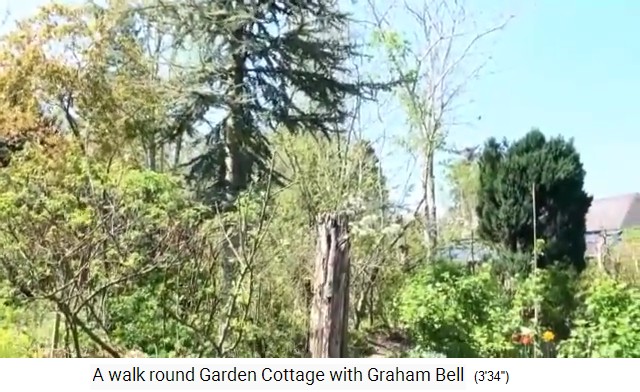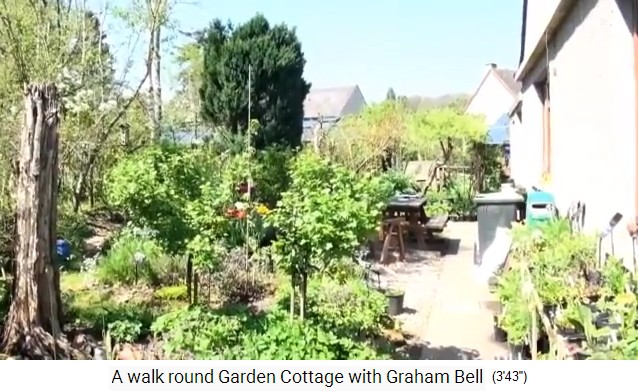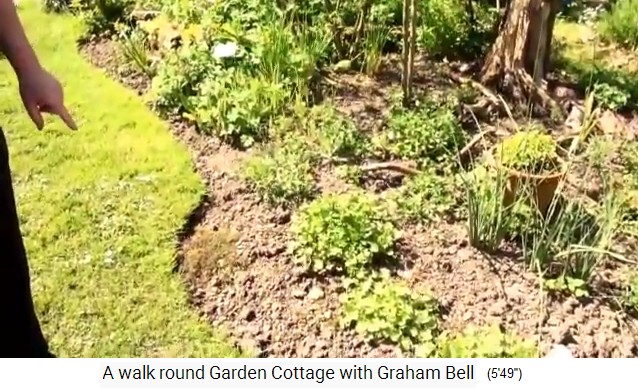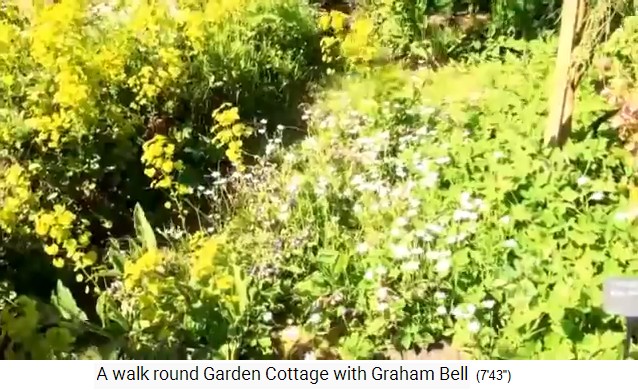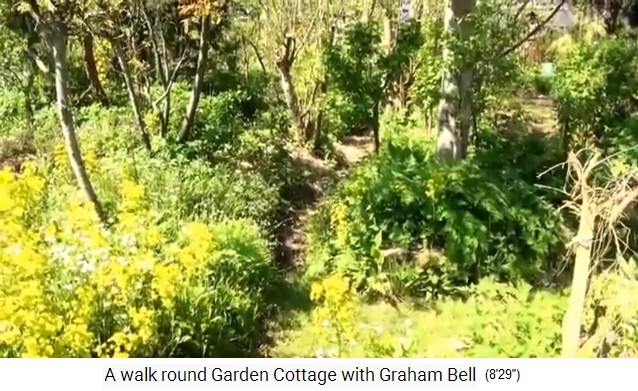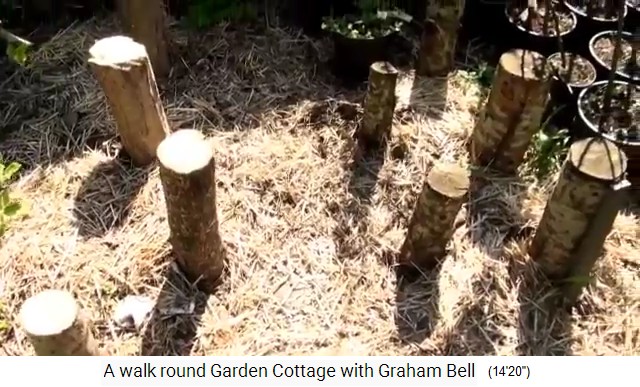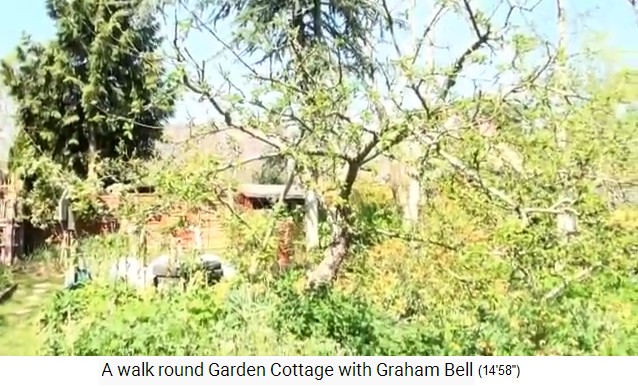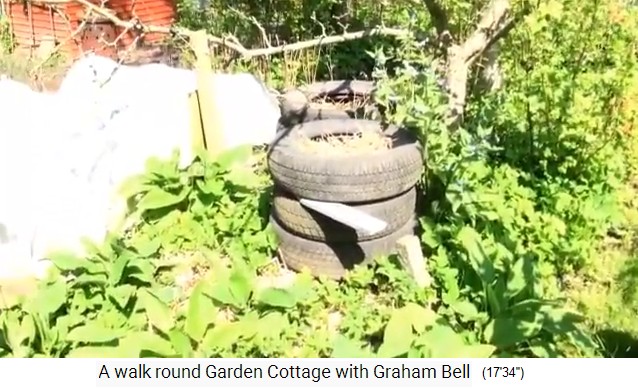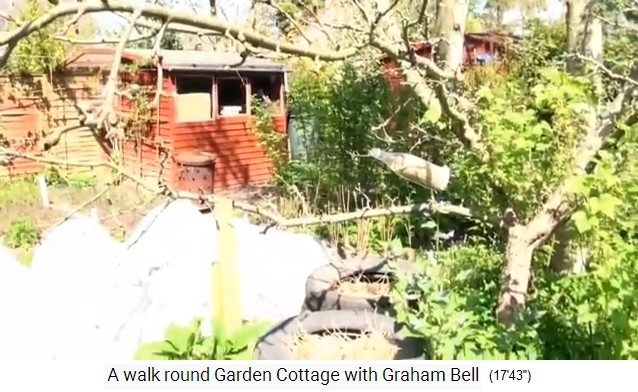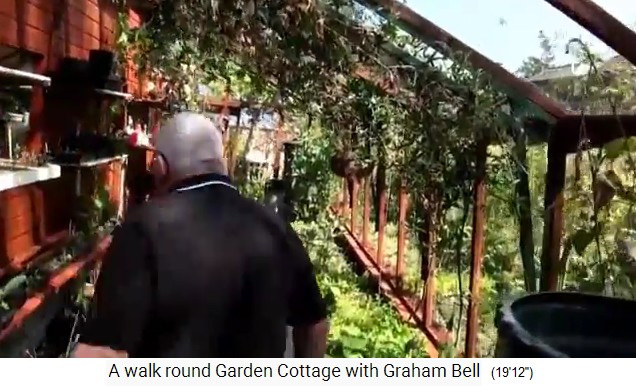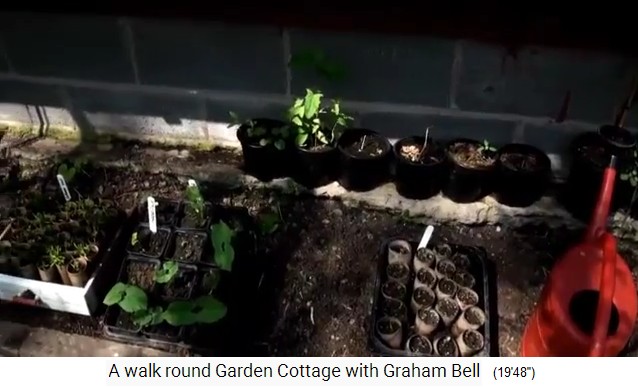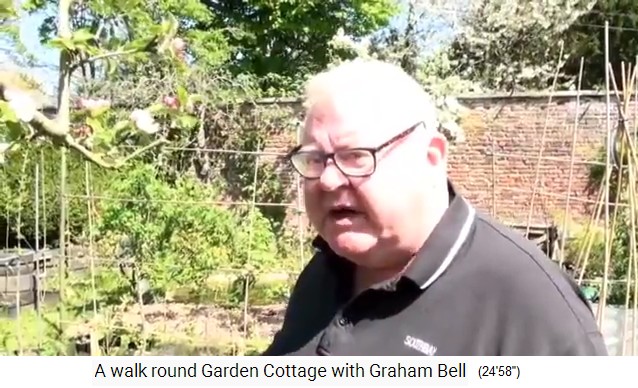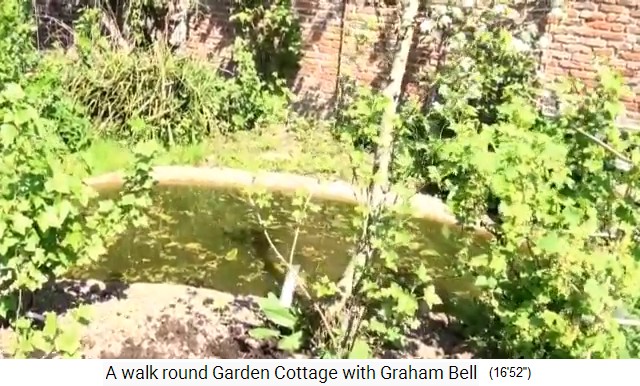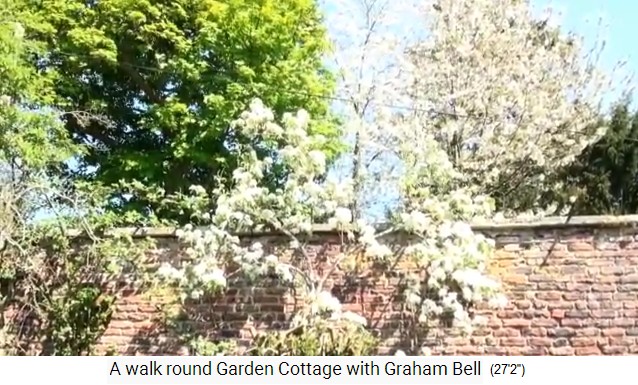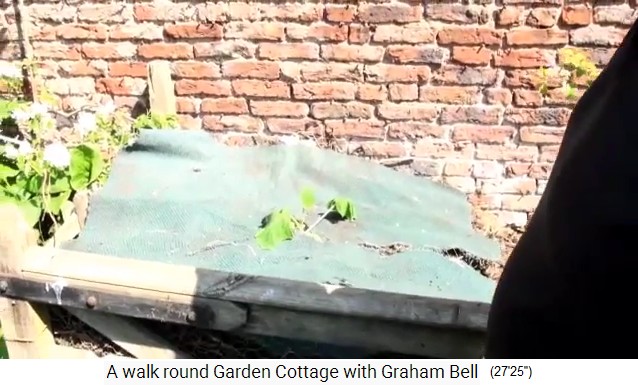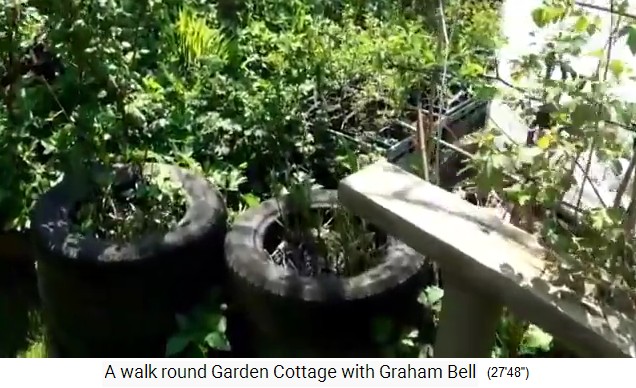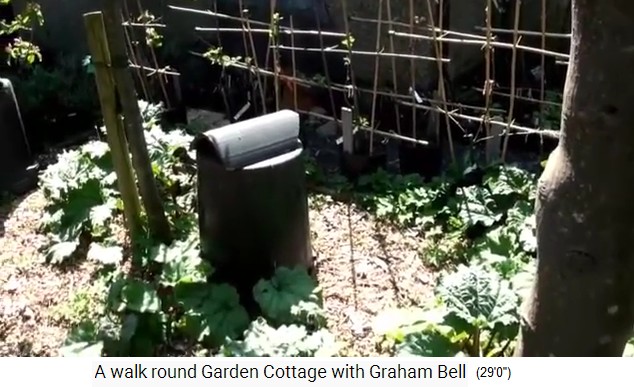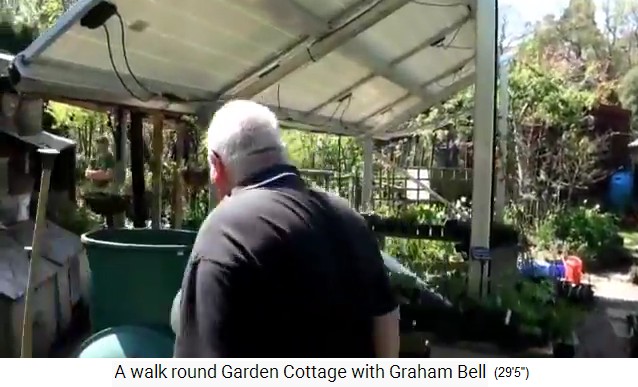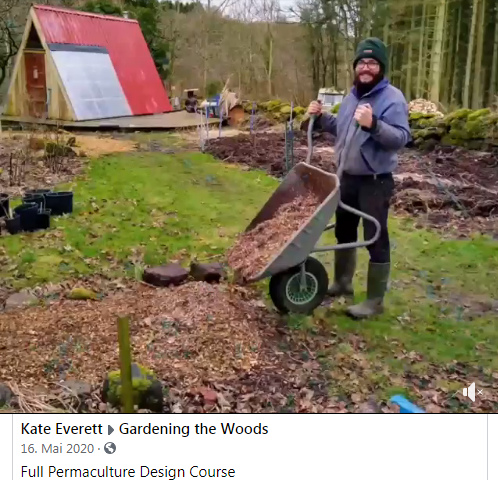Graham Bell's orchard (Southern
Scotland) (fruit forest garden,
forest garden, agroforestry)
Graham Bell lives in Northern England on the Scottish
border. He and his wife Nancy have created a forest
garden from which they take almost all their food and
cut firewood. The wildlife is fantastic. The two
children Ruby and Sandy develop the place in terms of
energy efficiency. [web02]
See the photos from a movie:
Web sites of Graham Bell
-- Courses with Graham Bell: http://grahambell.org/
--
Graham Bell on Facebook: The Red Shed: https://www.facebook.com/theredshednursery
-- Graham Bell's articles on his
website: http://grahambell.org/posts
-- video about Graham Bell's orchard:
http://www.permaculture.co.uk/videos/oldest-food-forest-britain
-- Videos über Graham Bell und seine
Permakultur: https://www.youtube.com/results?search_query=%22graham+bell+%22+permaculture
"The earth will take care of us if we take care of
her." (Graham Bell) [web01]
Graham Bell cannot understand why governments are
still spraying pesticides [web01].
Graham Bell: Why do we need wildlife
https://permaculturenews.org/2017/03/23/why-do-we-need-wildlife/
The list: aphids and their natural opponents: blue
tits, ladybirds, lacewings - field edges attract
invertebrates and songbirds etc.
-- Aphids and the yellowing disease can be eliminated with
opponents: blue tits, ladybirds, lacewings [web01]
-- Field edges attract invertebrates and songbirds [web01]
-- Agriculture and forestry are one unit, they cannot be
operated separately [web01]
-- Monocultures eliminate wild animals [web01]
-- Scavengers (slugs, rats) remove animal carcasses
[web01]
-- Invasive exotic species (giant hogweed, Japanese
knotweed, Himalaya balm, New Zealand flatworm, mink)
should not be allowed to grow in because they have no
natural predators [web01]
-- Birds of prey and badgers do no harm [web01]
-- Wasps pollinate, break down dead wood, eat snails
[web01]
-- Thistles and nettles are pioneer plants for the
regeneration of damaged soils, they are food plants for
butterflies and moths, and they are medicinal plants
[web01]
-- Earthworms are floor care workers [web01]
-- Weeds create new soil [web01]

Slogan of life by Graham Bell: Be the inspiration [7]
Quote:
<Abundant wildlife is the first
sign of a healthy planet. For far too long (like since
the birth of chemical agriculture in the late
nineteenth century) we have thought humans can control
Planet Earth. Previous retrograde steps would be the
enclosures of the eighteenth and nineteenth centuries.
For Scotland, the Highland clearances spring to mind.
Any intelligent management of the land and our
ability to live from it recognises the need for Earth
Care. The Earth will care for us if we care for it. We
are people and therefore need People Care. But we do
not care for ourselves by a misguided belief that we
can dominate the rest of nature and win.
Here’s a small example. Aphids are widely regarded as
‘a problem’. They are vectors
(carriers) of various diseases e.g. Virus Yellows.
Aphids are prolific insects if uncontrolled. But we
don’t need to control them. All we need to do is
encourage their natural predators. For example, blue
tits, ladybirds, lacewings. These native species are a
delight to see and eliminate the need for chemical
sprays if we have them in profusion. So all we need to
do is create the right habitat and leave the natural
cycle of life to deal with itself. Aphids aren’t the
problem. Keeping nature in balance is the challenge.
Wide field margins that attract invertebrates and
songbirds assist.
[Agriculture and forestry are one unit - the 5
dimensions of nature: space with trees, time,
relationships (interactions)]
The idea that agriculture and forestry are separate
activities is the next mistake we have made. Nature
operates in five dimensions. Over, under, sideways,
down in the words of the old pop song. The three
dimensions of physical space. Our farmers do a
fantastic job on the two dimensions of flat space. But
the third dimension of vertical space requires two
things: creating living organic soils (impossible with
chemical farming which destroys life in the soil) and
trees. Trees offer us the best chance of
permanent habitation. They ameliorate climate, build
soils, offer useful products and create habitat for
wildlife.
The fourth dimension is time. Under
the supermarket culture we have lost our respect for
seasonality, expecting abundant harvests of everything
we consume every day of the year. Our commitment to
uniformity is destroying our understanding of the
value of diversity. Different things happen at
different times of the day, and of the year. If we
respect this then we need to work much less and make
less inputs. True yield is outputs minus inputs, not
tonnages achieved. Let nature take its course and
we’ll progress further for less work and cost.
Monocropping does not favour wildlife. Managing our
salmon rivers to extinguish coarse fish is not going
to increase our national wealth, just the wealth of a
few. Mono – anything is anathema.
[Appreciate scavengers - remove invasive exotic
species]
Everything in nature has a right to life. If you don’t
like a particular (native) plant, invertebrate, animal
or bird, just consider what its role is in the system.
Without detritus eaters (slugs, snails, rats etc.)
we’d be feet deep in rotting vegetation. I exempt
invasive exotics (Giant Hogweed, Japanese Knotweed,
Himalayan Balsam, New Zealand Flatworm, Mink) because
they were never part of our natural environment and
they don’t, therefore, have natural predators.
[Birds of prey and badgers]
But I despair to see people who want to eliminate
raptors and badgers. They are part of the beauty of
our natural world. If we abandon nature we abandon
life. Badgers are ‘bad’ because they
give bovine tuberculosis to cattle. The Government’s
own research shows that 80% of the time it’s the other
way round. Makes sense if you think about it. Badgers
trundling around pass through cattle at ground level
(cowpat territory). Cattle don’t spend time hobnobbing
with badgers.
[Wasps pollinate, break down dead wood, eat
snails]
Many people are intolerant of wasps. But they serve
lots of useful functions – pollinating, breaking down
dead wood, infesting slugs and keeping their
populations under control.
[Thistles and nettles]
Thistles and nettles are pioneer plants repairing our
damaged soils and great food plants for a wide range
of butterflies and moths. And for us if we know how to
use them.
This is the fifth dimension. Relationships and
cross effects. In this zone we find the
true foundation of natural abundance. How does all
creation work together to provide our needs? As you
enjoy our countryside ask yourself whenever you look
at a plant, and insect, or an animal or bird – “How
is it helping me.”
[Earthworms are the floor care workers]
Without earthworms we couldn’t live. Fantastic soil
creators.
[Mushrooms and their meaning]
Fungi serve us massively in ways we are barely
beginning to understand.
[There are no weeds - weeds create new soil]
Weeds? Well they create new soil and all our food
crops were weeds once.
Every tree on planet earth, capturing carbon dioxide
and giving us back oxygen is a gift to our ability to
live on planet Earth. A life we would not have without
abundant wildlife.
[Bare moors in Scotland were caused by
incorrect farming]
The great ecologist Frank Fraser Darling described
Scotland’s bare moorlands as ‘a wet desert’.
He wasn’t wrong. Let’s stop our lowland agriculture
going the same way, and regenerate woodlands on our
uplands. The inevitability of carbon descent (oil
running out) means we’ll have to get much better at
managing our land and using organic production to
produce the food we need.>
[Well: Oil is NEVER running out because the
deposits are always filling again].
Graham Bell: Yield is theoretically
unlimited
https://permaculturenews.org/2016/09/13/yield-theoretically-unlimited/
 |
One food forest
at a time- Graham Bell, Global Change Agent,
Scotland.
The text:
“I live here on the Scottish Border in northern
Britain the same latitude as Alaska, Moscow, and
so on. If I was in the Southern
hemisphere, I’d be south of McQuarrie Island
like South Georgia or somewhere.
My wife, Nancy and I share an intentional food
forest garden.
It’s 800 sq meters. Or .08 of a
hectare. A fifth of an acre in old money.
In crowded Britain, people think that’s a big
garden. In suburban Australia or the USA,
it’s a typical backyard.
Peak yield in this garden is 1.25 metric tonnes
of food, 500 trees and 5000 plants for sale, a
thousand visitors in a year, a teaching space,
and a soft living room.
37 species of birds’ nest in this garden, 20
come for their lunch and 20 more on their
holidays. People who know more than me
about it tell me there are 500 hundred species
of invertebrates here.
And we don’t do pest control.
We have willing workers on organic farms
WWOOFERS. Two tonnes of them.
They’re called earthworms. That’s the
weight of thirty fit strong young men. But
these guys dig seven days a week and fifty-two
weeks of the year. They digest botanical
waste and turn it into TOPSOIL!!!
Right now (May is our Spring) there are sixty
species of plant you can eat in a salad.
One hundred varieties of apple… and so much
more.
What’s the secret?
Stop. Think. Learn. Let nature
do the work. Eliminate waste. Become
a guardian of the living world and stop
exploiting it. Share the surplus it offers
and share your surplus with others.
Open your mind, open your heart and you will be
buried in abundance.
Many people feel we are in difficult times. I
actually think we are in immensely positive
times. Time of opportunity and
learning. Opportunity to change human
behavior for the better. Time to care for
the planet better.
Thank you for listening”.
And thank you Graham for sharing your story and
thoughts- we all need to hear these messages.
Check out Graham's website http://grahambell.org
The site https://localpermacuture.com/
is also recommended.
𝐈𝐟 𝐲𝐨𝐮 𝐡𝐚𝐯𝐞 𝐚 𝐟𝐨𝐨𝐝 𝐟𝐨𝐫𝐞𝐬𝐭
𝐨𝐫 𝐞𝐝𝐢𝐛𝐥𝐞 𝐟𝐨𝐫𝐞𝐬𝐭 𝐠𝐚𝐫𝐝𝐞𝐧
𝐭𝐡𝐞𝐧 𝐩𝐥𝐞𝐚𝐬𝐞 𝐜𝐨𝐧𝐭𝐚𝐜𝐭 𝐮𝐬.
We would love to share your story.
|
The article:
The list
-- The Amazon has been there since ancient times, and the
indigenous people, who have lived in the jungle for 5000
years, tend it as a forest garden
-- Graham Bell harvests 16 tons per hectare in his 800
square meter forest garden
-- and all this happens in cold Scotland with rarely 20
degrees.
Quote:
[The Amazon jungle is a forest garden]
<Well in practice we find this to be a truth, not a
theory. Over time our yields just keep growing. And we
can always find more ways to get more out of the system.
The native peoples have managed the Amazon Rainforest
for 5,000 years since they first arrived there. Treading
very lightly. But hey there’s always room for more tree
houses. No?
[Graham Bell's small forest garden: 800 square
meters - 16 tons per hectare per year - the principle
of stacking]
Our very small back yard (800 sq metres) currently
produces food at the rate of 16 tonnes / hectare. I
don’t know any farmers round here who get that. It also
produces half of our energy needs (firewood and
electricity) 500 trees and 5000 plants a year for sale,
a teaching space and a soft living room. And we are
always trying to find what else we can stack in. Oh,
stacking! Another key permaculture principle.
Of course the first thing that matters in any
permaculture system is what you start out with. It helps
to get really good at noticing stuff. Climate and
weather (they’re not the same thing) have certainties
and uncertainties. What applies where you are (or where
you are working and designing for others?).
[Permaculture with soil science and tools -
management of finances must work]
What are the soils like? How would you improve them?
Mineral fraction, humic content, and most importantly,
life in the soil. Do you know your species? The best
willing workers on organic farms (WWOOFERS) are in the
soil.
What tools do you have and what do you lack? Tools come
in many forms: hand tools, mental tools, behavioural
tools, big kit… Are they sharp and current, well
lubricated? That applies literally to physical tools
metaphorically to mental tools [further education!].
What financial resources do you have? It’s important to
live within them. Or can you provoke new finance through
borrowing, crowd funding, generosity? Maybe you will
create profit from your surplus.
What will be the risks you face? Have you measured them
and do you have a plan how to deal with them? Projects
die from want of cash flow long before lack of profit.
What about health risks? Who are the predators which
threaten your system and how will you manage them?
Already we see that one of the key things that
permaculture offers us is not answers, but the right
questions to ask. Because the solutions are different in
every place tailored to time, aspect, resources, skills
and so on.
[Cold Southern Scotland - the harvest]
I’m writing this in my home in the South of Scotland.
Same latitude as Alaska, Moscow, Northern China. If we
were in the Antipodes we’d be McQuarrie Island, South
Georgia…or thereby. I’ve spent most of the last month
processing the food we have harvested. Bottling fruit
and vegetables. Freezing soft fruit. Fermenting
vegetables (to eat) and fruit (to drink). Drying onions
and garlic, making kale crisps. Harvesting seeds to
share with others.
I’m always thinking: “if only we had another pair of
hands to help”. Then we could do so much more. The
freezers are full. We have chutneys pickles and kimchi
galore. Jars full of rumtopf, flavoured vinegars, salad
dressing, pickled garlic, and we’ve run out of places to
dry herbs.
Just imagine what you could do if you applied these
principles in a warmer climate -where harvests can be
heavy all year round.
[Food poverty in Scotland]
Our next project here in Scotland is to create sites
like this all across our region to make a determined
effort to eliminate food poverty. It seems criminal to
me that there are people in a supposedly civilised
country like the United Kingdom going hungry today. But
there are.
[The poverty of ambition in the world]
It’s not just about food poverty, it’s about poverty of
ambition (first noticed by Adam Smith the Scots father
of economics), inadequate housing, and lack of feeling
self-worth.
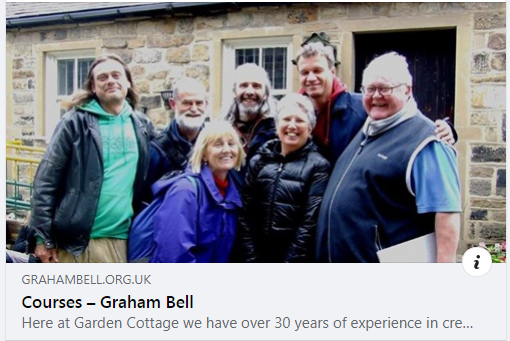
Graham Bell with a group at a garden cottage, Post on FB
from Feb.3, 2020 [9]
[Scotland with rarely over 20 degrees]
So whilst we are harvesting our bumper crops from our
cool summer (rarely passing 20 degrees centigrade) I
wonder ate the gift that permaculture insight offers to
increase yield throughout the world.
We know how to create and maintain clean air, adequate
water supplies, and sufficient quantity and quality of
food for all. We know how to create dwellings and work
spaces which offer, shelter, companionship and human
dignity. We know how to turn wastes into resources to
keep the cycle of productive yield growing year on year.
Health warning: all good change is incremental. It
doesn’t happen overnight.
[The permaculture movement encompasses the whole
world]
One of the great strengths of the permaculture movement
is that it is truly international, does not measure any
of the divisive issues that trouble our planet: skin
colour, race, religion, class, property ownership,
wealth or poverty. It is a truly egalitarian movement
that recognises we all have a right to a decent standard
of living and that we will best achieve that by sharing
it with all living beings who actually are the source of
earth’s natural abundance: be they other people, trees,
songbirds, whales or microbial beings.
I feel privileged to be coming to share my surplus with
whoever is up for it at the Permaculture Research
Institute this October.
Graham Bell and his wife, Nancy Woodhead, welcome
visitors to their forest garden by appointment. You can
book on courses and open days, or make contact for other
engagements via the website.
Sign up to the Red Shed Nursery on Facebook and @redshednursery on
twitter to stay in touch.
You can see a short film of the garden here:
www.permaculture.co.uk/videos/oldest-food-forest-britain
Graham Bell is the author of two books: The
Permaculture Garden and The Permaculture Way, both
available from:
www.green-shopping.co.uk/books/pp/graham-bell.html>
